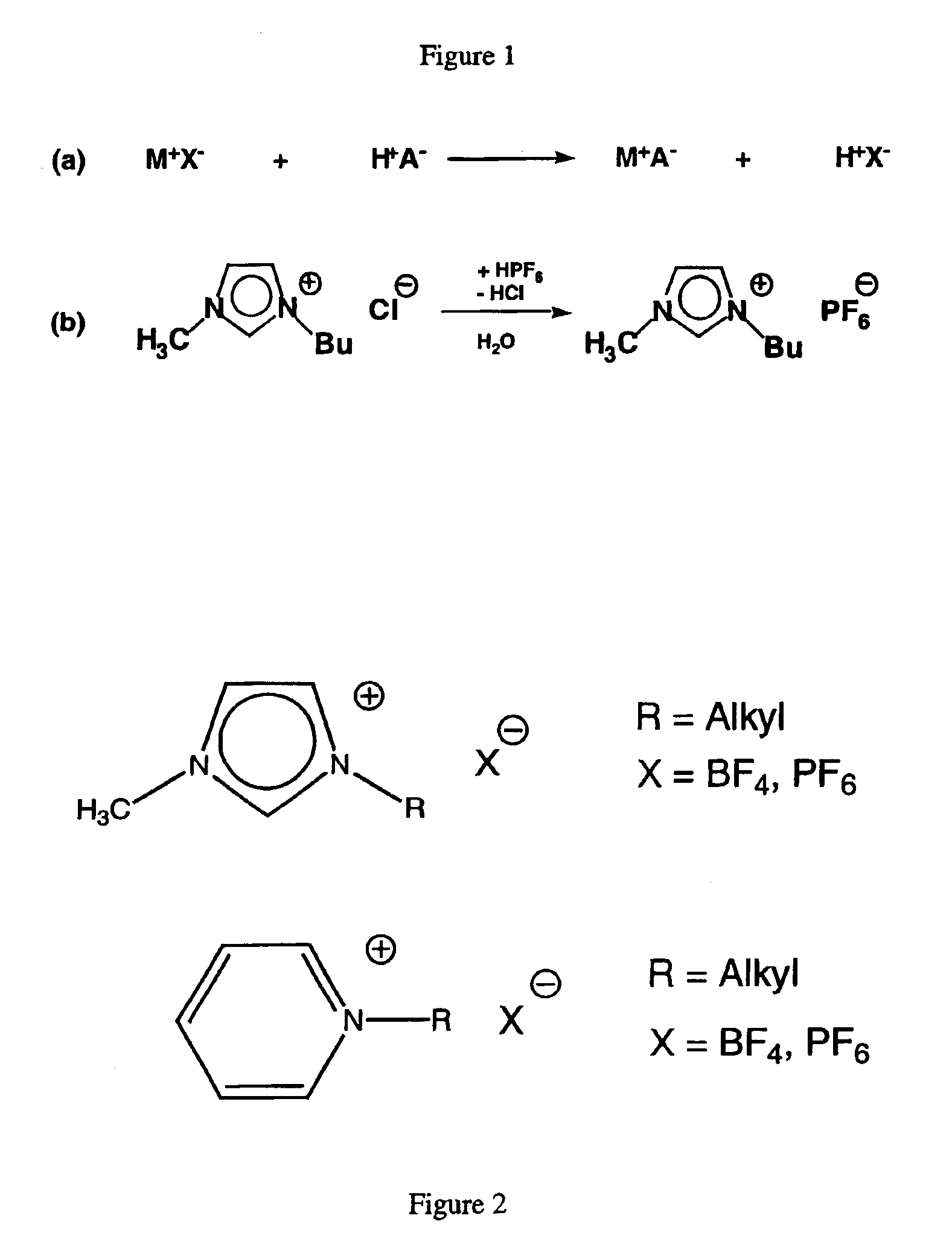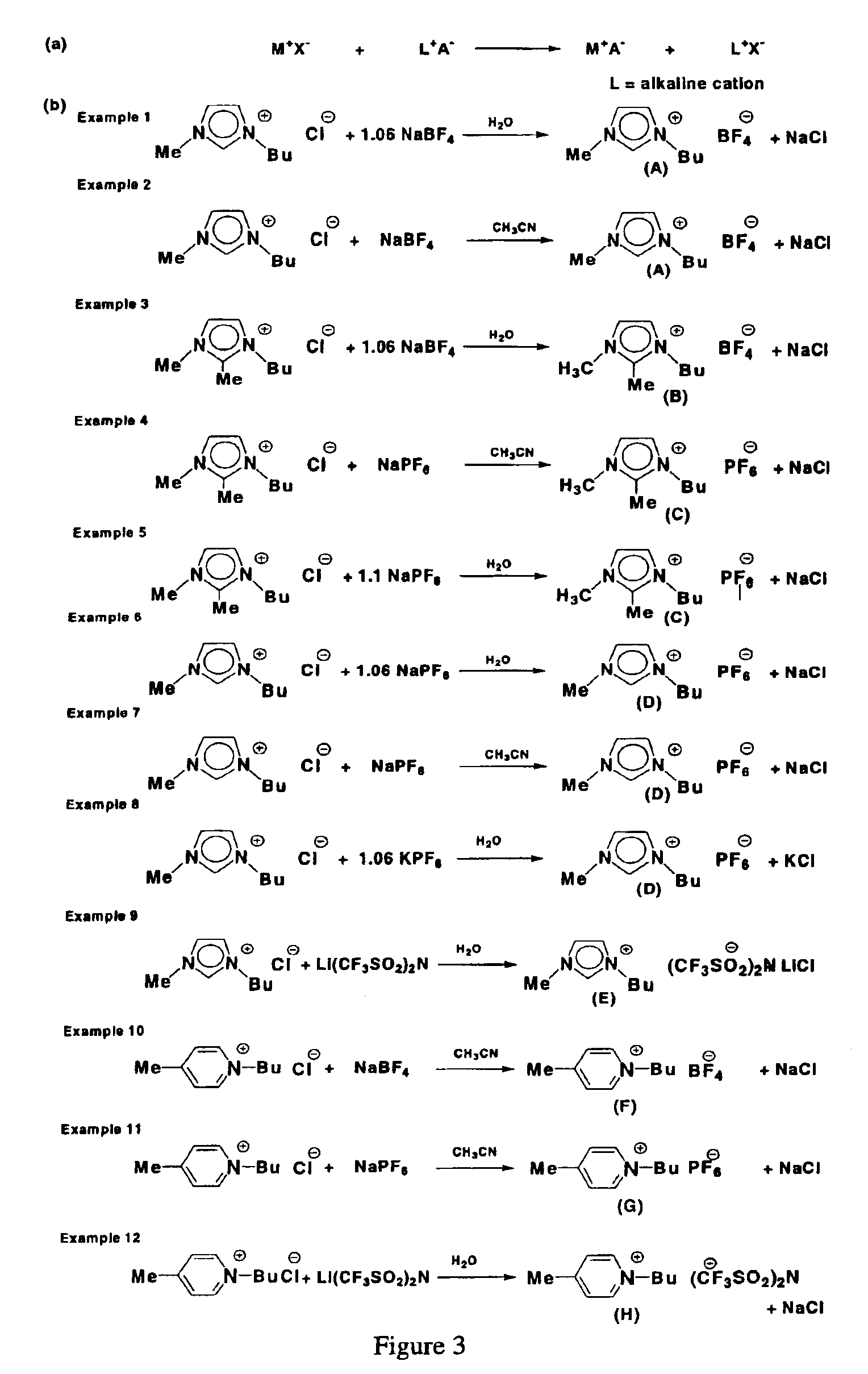Method for preparing high-purity ionic liquids
a technology of ionic liquid and production method, which is applied in the direction of sedimentation separation, chemical/physical processes, sedimentation separation by centrifugal force, etc., can solve the problems of contaminated products, formation of undesired products, and destruction of catalysts
- Summary
- Abstract
- Description
- Claims
- Application Information
AI Technical Summary
Benefits of technology
Problems solved by technology
Method used
Image
Examples
example 1
Synthesis of 1-Butyl-3-methyl-imidazolium Tetrafluoroborate (A)
The compound 1-(butyl)-3-(methyl)-imidazolium chloride (0.54 mol, 94.6 g) and sodium tetrafluoroborate (1.06 eq.) (0.57 mol, 62.5 g) were dissolved in distilled water (0.25 L). After 15 hours, the reaction mixture containing the ionic liquid 1-(butyl)-3-(methyl)-imidazolium tetrafluoroborate (compound A) was treated with dichloromethane. The resulting mixture was stirred for approximately an additional 10 minutes. After the stirring was stopped, the phases separated into the polar phase and the aqueous phase. The polar phase was separated from the aqueous phase by decantation. This extraction procedure was repeated 3 times using dichloromethane (3×0.2 L) as the polar extractant. The combined polar phases were dried over magnesium sulfate and filtered through a filter aid combination made up of aluminum oxide and activated carbon. After the removal of the volatile components under reduced pressure (10−2 torr), compound A ...
example 2
Synthesis of 1-Butyl-3-methyl-imidazolium Tetrafluoroborate (A)
The compound 1-(butyl)-3-(methyl)-imidazolium chloride (1.3 mol, 230.0 g) and sodium tetrafluoroborate (1.3 mol, 144.6 g) were stirred as a slurry in acetonitrile (0.5 L) at room temperature. After a reaction time of 4 days, the resulting mixture containing the ionic liquid 1-(butyl)-3-(methyl)-imidazolium tetrafluoroborate (compound A) was filtered through a Celite filter aid. The clear liquid was freed from the volatile components by evaporation under reduced pressure (10−2 torr). Compound A was recovered as a clear, colorless liquid in 90% yield (1.2 mol, 268.6 g). 1H NMR (CD3CN) δ=0.93 (m, 3H, CH2—CH3), 1.31 (m, 2H, CH2—CH3), 1.79 (m, 2H, CH2-CH2—CH3), 3.84 (s, 3H), N1—CH3), 4.15 (m, 2H, N3—CH2), 7.39 (s, 1H, C5I—H), 7.42 (s, 1H, C4I—H), 8.57 (s, 1H, C2I—H) ppm; 13C-NMR (CD3CN) δ=13.64 (CH2—CH3), 19.92 (CH2—CH3), 32.54 (CH2—CH2—CH3), 36.71 (N1-CH3), 50.18 (N3-CH2), 123.18 (C4I), 124.56 (C5I), 137.08 (C2I) ppm; elemen...
example 3
Synthesis of 1-Butyl-2,3-dimethyl-imidazolium Tetrafluoroborate (B)
The compound 1-(butyl)-2,3-(dimethyl)-imidazolium chloride (0.30 mol, 56.6 g) was dissolved in distilled water (0.4 L) to give a hazy amber colored solution. After stirring for 15 hours, the clear amber colored solution was treated with sodium tetrafluoroborate (0.33 mol, 36.2 g) at 45° C. The mixture was stirred for 2 days and then treated with dichloromethane. The resulting mixture containing the ionic liquid 1-(butyl)-2,3-(dimethyl)-imidazolium tetrafluoroborate (compound B) was stirred for approximately an additional hour. After the stirring was stopped, the phases separated into the polar phase and the aqueous phase. The aqueous phase was separated from the polar phase by decantation. This extraction procedure was repeated 3 times using dichloromethane (3×0.2 L) as the polar extractant. The combined polar phases were dried over magnesium sulfate and filtered through a filter aid combination of aluminum oxide and...
PUM
| Property | Measurement | Unit |
|---|---|---|
| pressures | aaaaa | aaaaa |
| pressure | aaaaa | aaaaa |
| reaction time | aaaaa | aaaaa |
Abstract
Description
Claims
Application Information
 Login to View More
Login to View More - R&D
- Intellectual Property
- Life Sciences
- Materials
- Tech Scout
- Unparalleled Data Quality
- Higher Quality Content
- 60% Fewer Hallucinations
Browse by: Latest US Patents, China's latest patents, Technical Efficacy Thesaurus, Application Domain, Technology Topic, Popular Technical Reports.
© 2025 PatSnap. All rights reserved.Legal|Privacy policy|Modern Slavery Act Transparency Statement|Sitemap|About US| Contact US: help@patsnap.com



